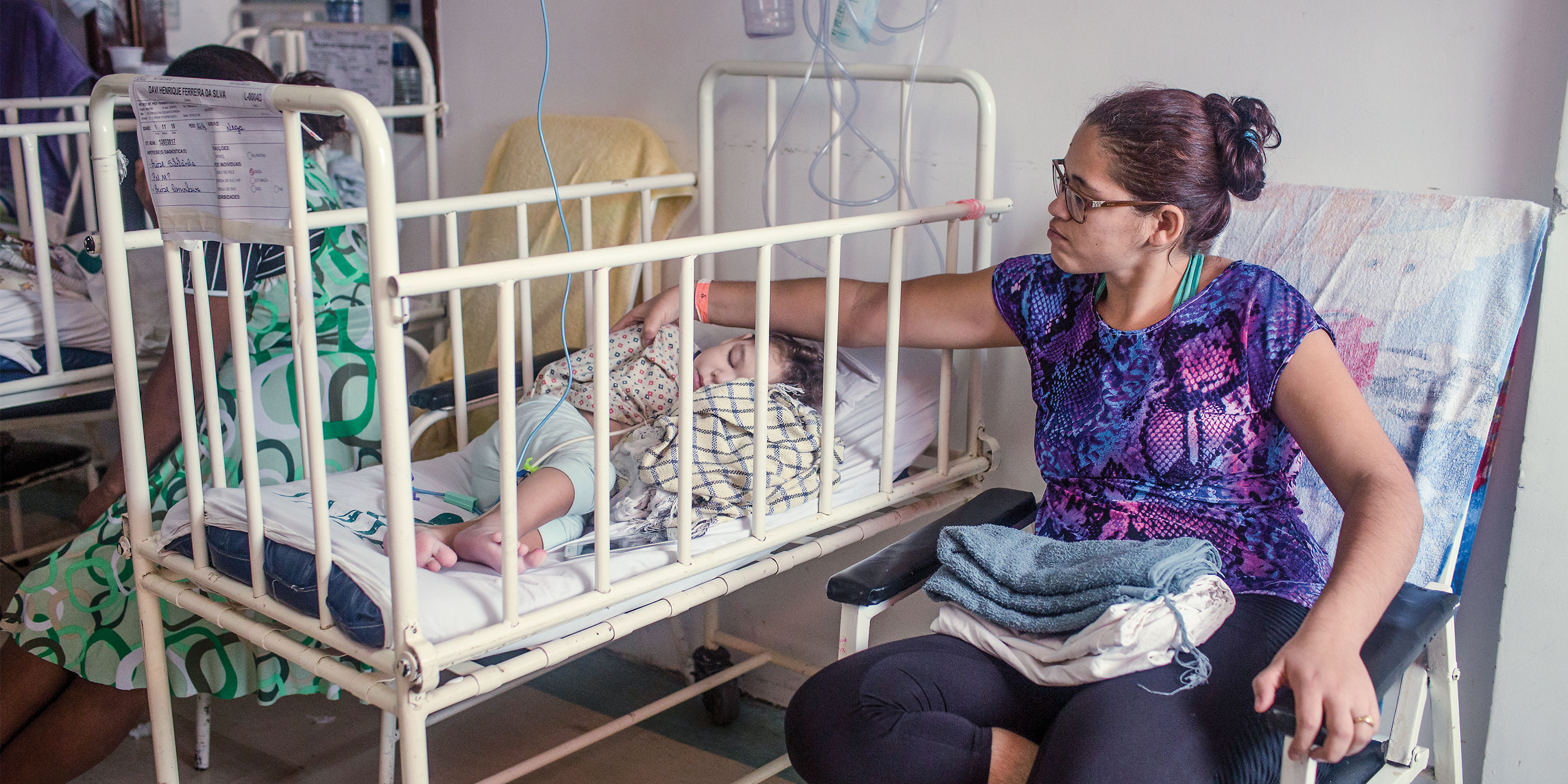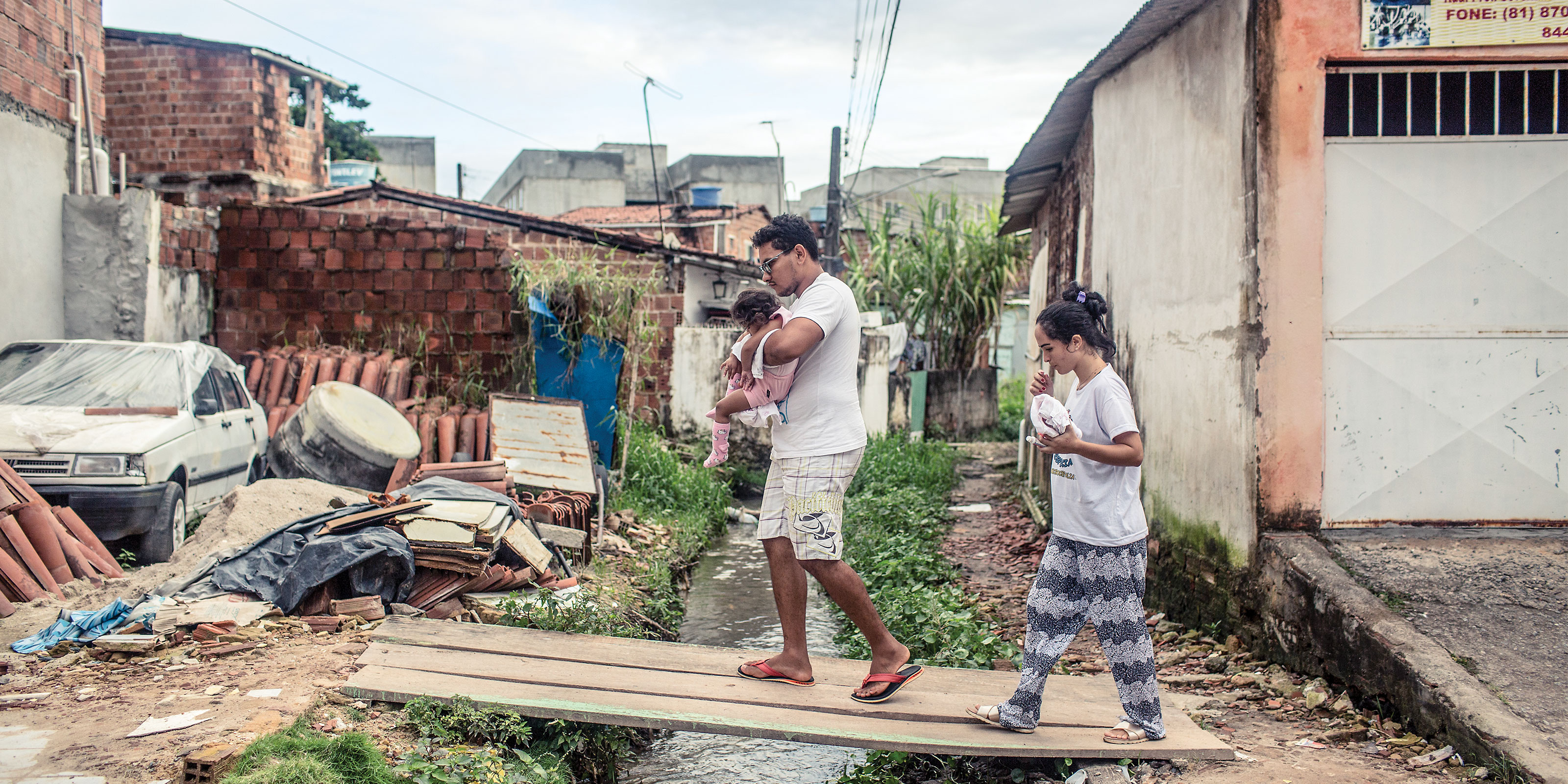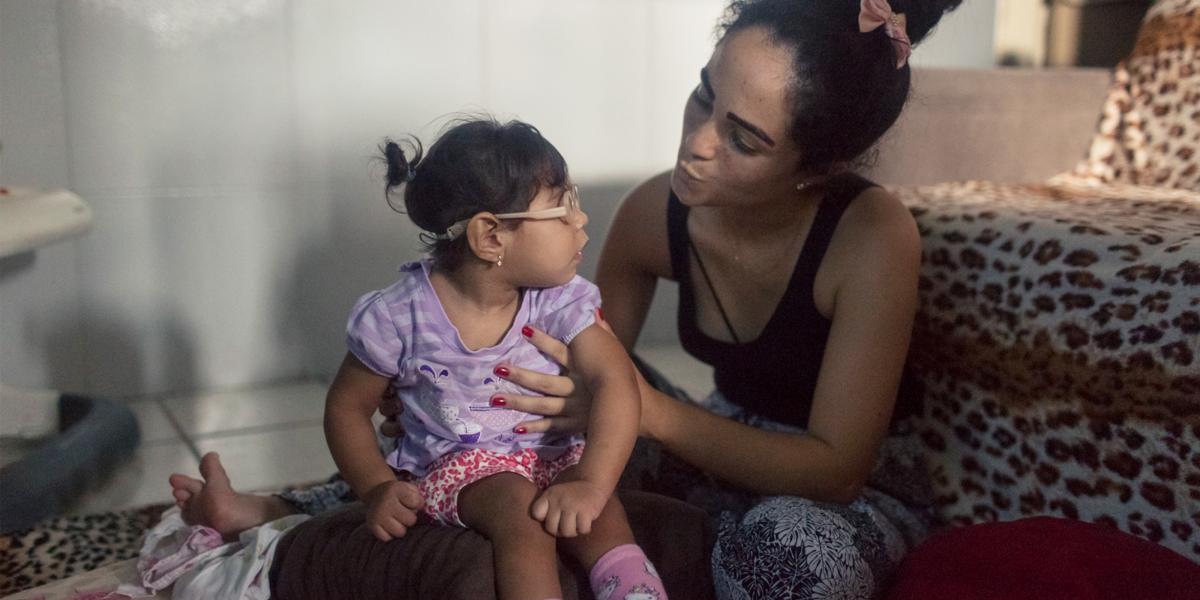Zika’s Never Ending Emergency
In Brazil, the all-consuming work of caring for children with congenital Zika syndrome falls to their mothers.
Dhulha Alen Silva do Nascimento, 25, stops speaking mid-sentence, her attention diverted to her two-year-old daughter, whose tiny body has become rigid in her arms.
Born in November 2015 with congenital Zika syndrome (CZS), Valentina experiences regular seizures, often several a day. With deftness and no trace of alarm, Nascimento cradles her daughter, coaxing her muscles to relax and waiting for the spasms to pass.
Nascimento often jokes that she became a nurse after having Valentina. Her remarkable knowledge of the clinical complexities of CZS and skill in performing physical therapy exercises with her daughter testify to her acquired knowledge.
Sometimes, however, the young mother can’t help but think about her life before Valentina was born.
“I used to go out almost every night,” Nascimento recalls.
With her bright red lipstick and buoyant laugh, it is easy to imagine her in those days. “I loved to meet up with friends, get dressed up, go dancing, have fun in town,” she says. “Now, I dread each day that I have to leave my home,” says Nascimento, referring to the difficulties of navigating public transportation with Valentina.
Mylene Helena dos Santos Ferreira, 23, whose son Davi was born in August 2015 with CZS, shares many of Nascimento’s sentiments. She developed chronic back and arm pain, conditions she believes are linked to holding Davi, who does not yet have the motor function to sit up independently. Until a benefactor helped her purchase a specialized wheelchair, she had to carry him everywhere and constantly.
As far as most of the world is concerned, the Zika crisis, first identified in Brazil in 2015, is over: The Brazilian government declared an end to the emergency in May 2017, five months after the WHO. Zika is another epidemic that seized global attention, sparked temporary panic and receded into the background.
Not so for Nascimento and Ferreira—or for the other caregivers of 14,558 children in Brazil alone who are believed to have CZS as of September 2017.
Now, they belong to a community of mostly women, doing the day-to-day, full-time work of raising children with complicated needs and uncertain futures. Many will likely require a lifetime of expensive, specialized care.
LOSS OF SELF
The label “caregiver” itself flattens the multiple identities of women raising children with CZS.
Nascimento was a restaurant manager pursuing a business administration degree when Valentina was born. She planned to hire a babysitter and return to work and school; so far, neither has been possible.
Ferreira, once a telemarketer by day and artisanal baker by night, harbored ambitions of going to culinary school. She continued working for four months after Davi was born but was asked to resign because of her excessive absences.
She also received a scholarship to pursue an online degree in nutrition, a path motivated by Davi’s difficulties swallowing. However, with no one to watch him, she could not leave home for the few hours needed to take her required in-person exams.
Many mothers, some of whom may have previously had some degree of financial autonomy, are now reliant on government support or the income of their husbands—if their husband is employed and not estranged from the family.
Ferreira left her husband of eight years when Davi was four months old. She relies primarily on a monthly federal disability benefit, Benefício de Prestação Continuada (BPC), of R$937 (US$297) a month per family.
Nascimento’s husband was laid off and now earns R$1,000 a month in occasional car wash and construction gigs, disqualifying her family from receiving BPC.
Excluding expenses for other children, rent and general household necessities, monthly CZS-specific expenses alone can range from R$1,100 to R$1,400.
Because the Zika epidemic hit especially hard in areas marked by poverty, poor sanitation and structural inequity, many of the families who have a child with CZS were already living financially and socially precarious lives.
Despite the government disability benefits and other services, many mothers caring for children with CZS still struggle to get by. They maintain, as do several local and international human rights organizations, that the government response has been inadequate.
Expensive, lifesaving medications, as well as specialized foods and medical equipment not covered by the government, constitute the bulk of CZS spending. And those represent only the direct costs; a United Nations Development Programme 2017 assessment found that the indirect costs of microcephaly, including lost income, are six times the government benefit. The same UNDP report concluded that most costs will be borne by already marginalized populations: low-income, young, single women of color and African descent.
Nascimento survives with financial help from her husband’s family, while Ferreira receives support from a U.S.-based patron who read about her in a newspaper and now acts as Davi’s godfather. Neither can afford their rent, and both are awaiting approval for public housing. Nascimento already dreads the displacement from her childhood community, where her entire extended family lives, into the notoriously isolated and substandard conditions of public housing.
Economists have estimated that Zika is responsible for US$7–18 billion in lost GDP from 2015 to 2017 alone. Beyond these numbers, caregivers are experiencing a deeper sense of personal loss.
For Ferreira and Nascimento, who both live in Jaboatão dos Guararapes, a municipality bordering the south end of Recife, the intensive work of caring for a child with CZS has forced them to put other ambitions and relationships on pause.
Juliana César, a project advisor at Gestos, a Pernambuco-based NGO focused on health and human rights, agrees that the situation is deeply troubling.
“If these children die, which some are, what are these women going to do? They are so invested in their children that they don’t have a life for themselves anymore,” César says. “So far, none of the measures provided by the government are specifically intended to support the mothers or ensure their rights. Everything, from the free transportation to the minimum salary, has been focused on either the mosquito vector or the babies—not the mother.”

MECHANISMS OF RESILIENCE
Dissatisfaction with the Brazilian government’s response in the aftermath of the epidemic precipitated a surge in social action and support groups among mothers, including União de Mães de Anjos (UMA), a network of more than 400 mothers who have children with CZS.
Contrary to media portrayals of CZS and microcephaly as tragic disabilities, these mothers do not lament the condition, and many consider their children a blessing. (UMA translates to “Union of Mothers of Angels.”) Rather, the mothers are mobilizing against the social and economic inequities in Brazil that fueled the epidemic and worsened in its wake. They’re demanding a response from the government that ensures the full protection of their rights, including the environmental conditions, health services and social and financial protections to live and raise their children with dignity and self-determination.
Many groups like UMA have gained momentum and critical mass on virtual platforms, such as WhatsApp, where mothers provide mutual support as well as new information about caring for children with CZS. Some of the groups have also moved offline to organize street protests, negotiate medication access, lobby government officials for policy changes and strategically engage the media.
These mothers “are the experts, the domestic scientists who have been key in advancing our understanding of CZS,” says Debora Diniz, a Brazilian feminist anthropologist and author of Zika: From the Brazilian Backlands to Global Threat. “They were the first to detect convulsions in children. White coats and biomedical groups need the caregiver in order to know what is going on.”
THEY ARE SO INVESTED IN THEIR CHILDREN THAT THEY DON’T HAVE A LIFE FOR THEMSELVES ANYMORE. SO FAR, NONE OF THE MEASURES PROVIDED BY THE GOVERNMENT ARE SPECIFICALLY INTENDED TO SUPPORT THE MOTHERS. ... EVERYTHING, FROM THE FREE TRANSPORTATION TO THE MINIMUM SALARY, HAS BEEN FOCUSED ON EITHER THE MOSQUITO VECTOR OR THE BABIES—NOT THE MOTHER.
Nascimento is in the process of launching her own NGO, Amo Um Ser Especial (AUSE), for the 65-plus families with children with microcephaly in her municipality.
“We want to raise money for basic survival essentials like milk and diapers, but what we need long-term is a specialized daycare with a multi-professional team so that we can return to our lives,” she explains. “Once the daycare is open, I want to start university again and finish my business administration degree, and then do another course in a field related to Valentina’s needs.”

Pompéia Villachan-Lyra, PhD, an education researcher and professor at Universidade Federal Rural de Pernambuco, thinks it is the government’s responsibility to make public schools inclusive and accessible for children with CZS, which she says is a constitutional right. In the meantime, however, Villachan-Lyra supports the daycares—and not just for the child’s benefit.
“We know that the emotional situation of the families will impact the baby’s outcomes,” she explains. “A specialized space is good for baby because it will promote their development, but also it’s good for mother—they need some time for themselves.”
Nascimento has enlisted the support of a local politician to build a separate space in the community health clinic for the care and rehabilitation of children with CZS, a move that has cut down her near-daily trips to the state capital, Recife, where specialized health care services have historically been concentrated.
Ricardo Ferreira Jr., a primary care physician, stresses that localized care makes a difference. “These kids will have ongoing needs for the rest of their lives, and the big centers can’t meet the demand forever,” he says. “The needs of these families should be met in their own communities, where they live, by doctors who know them and their histories.”
Government officials in Pernambuco feel many of the critiques levied against their response are undeserved. They maintain that they are doing their best to support families and are opening additional centers around the state to increase access to care, but the expansion and uptake of new services have been slow.
While new cases of Zika infection are on the decline for now, families with children with CZS will continue living in the shadow of the epidemic for decades to come.
With a disorder as uncharted as CZS, and without societal protections that would enable them to thrive, little seems certain for these families. After all, as Diniz asks, “What is the meaning of an emergency, and what are the conditions for it to be fulfilled?”
For Nascimento and Ferreira, and the thousands like them, the emergency seems far from over.
Poonam Daryani, MPH ’17, is the 2017 Johns Hopkins-Pulitzer Center Global Health Reporting Fellow. She is the 2017–2018 Clinical Fellow with the Yale Global Health Justice Partnership, a joint program of Yale Law School and Yale School of Public Health. Interpretation was provided by Rafael Alkalai, Tiago Cabral, Adriana Bentes dos Santos, and Margarida Corrêa Neto.
